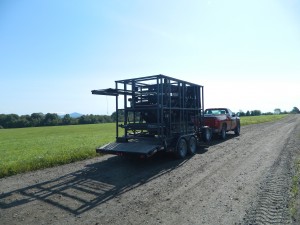
The UVM Mobile Hops Harvester visited six hop yards this year, harvesting approximately 400 dry pounds of hops, over a 4 week period plus harvesting the UVM Extension NW Crops and Soils Team’s research hop yard. This harvester, developed as a result of a Northeast Hops Alliance, UVM Extension, VT Agency of Ag Food and Markets, and MA Department of Agriculture sponsored project, aims to provide proof of concept of a mobile hops harvester in support of the re-emerging hop industry in the Northeast US.
The reintroduction of hops to the northeast requires scale-appropriate harvest and processing equipment. At the start of this project there was no feasible mechanized harvest options for a 1-2 acre hop producer. Handpicking is the most wide-spread current practice which is labor intense and time consuming leading to expense and quality impact due to delayed harvest.
As a result of this project, cooperative use of a single, mobile harvester has been demonstrated and logistics for this operation are being continually improved. The harvester has a demonstrated capacity of 60-120 bines per hour compared to 1 bine per hour per person for manual picking. This rate enables the harvest of a 1 acre yard within 8 hours resulting in optimal harvest timing and improved quality. Assuming a harvest team of 4 people in either case, this translates to a harvest labor cost savings of 97% or $3,120 per acre at $15 per hour wage (approximately $2 per lb of dried hops (10-20% of retail price)).
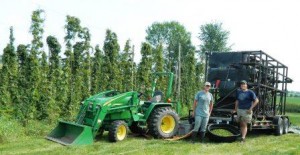
“The hop harvester significantly sped up harvesting. With the size of the bines this year, some may not have been harvested at all without it’s use. Knowing the UVM harvester is available helps me plan for hopyard expansion over time. Without a large harvester, such a UVM’s, expansion would not be practical.”, notes Kris Anderson of Addison Hop Farm in Addison, VT.
Trevor Lewis of Mad Mountain Hop Farm in Berlin, VT concurs, “Absolutely amazing! My harvest time went from 5 days to 5 hours! Though I am unsure of expansion at this time, this machine makes it possible to expand beyond a half acre which really isn’t an option without a harvester.”
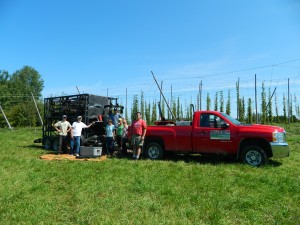
This mobile, trailer-based mechanized hop-harvester was developed and documented as an open-source design for others to replicate and adapt to their needs. The design was the result of a collaborative design effort involving growers, brewers, agronomists, fabricators and engineers. Additionally, 255 people have downloaded the plans for the machine and 5 others have built harvesters at least partially informed by this work. This harvester pulls a complete bine (central bine/vine, leaves and cones) through a section of stripping fingers that separate the cones and leaves from the bine. The cones and leaves are conveyed to a secondary sorting section with rolling dribble belts against which the leaves lie flat while the cones roll backward down the belts. In this way the machine takes a loaded bine and produces two output streams of cones and leaves.
We’ve been reasonably pleased with capacity and efficiency of the machine. There is still room for improvement, and we plan to install chutes and fences over the winter to better contain all matter within the machine, improve separation and, thus, net yield. We also had two bearings fail this harvest season and will likely upgrade them to heavier duty bearing housings.
The entire machine is placed on an 18 foot equipment trailer for ease of transport. This year, the machine traveled approximately 3,400 miles visiting some yards multiple times as different varieties matured. Each year, the harvester travels further afield for an outreach demonstration. This year we traveled to Westfield, Maine (Aroostook County) to Aroostook Hops to help with their harvest and to give them some experience with the harvester.
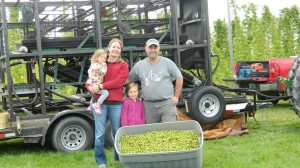
“Having the UVM mobile hops harvester had a HUGE impact on our success this year. We had a hops picking party the previous weekend (Labor Day) with many volunteers handpicking hops (we estimate about 60 people passed through that weekend) and we got about 40% of our crop harvested,” says Krista Johnston, ” We had two articles in the local press about us and lots of interest was generated, so we couldn’t have done better on “many hands”, but without the harvester here the following weekend we could not have gotten all the hops in this season by handpicking alone.”
Krista and her husband, Jason are thinking ahead to building a harvester of their own.
“We plan to fabricate a version of the mobile machine, so being able to use it ourselves and have our fabricators come out and operate it (for about 2 hours of time x two men) was absolutely invaluable to us. We had thought that “mobile” was less important to us and that we would build stationary with electric motors, but seeing how convenient it was to move around different locations made us reconsider that. Also, we recently expanded (last year) 3 acres so can’t even think about getting bigger any time too soon, but having the capacity to harvest at the rate that the harvester can accomplish will remove that as a limiting factor when we catch our breath and consider future operations. We do plan to contract our harvester to other growers, and had thought we’d have bines come to us, but mobile is looking attractive.”
Others have replicated and adapted the UVM design to their needs for the 2013 harvest season.
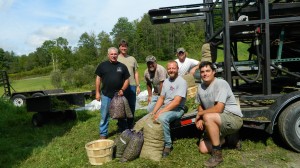
“We wouldn’t have been able to build our harvester without the knowledge and research from the UVM machine,” says Dean Heltemes of Lunatic Fringe Farms in Wisconsin. “I’m sure this picker will create a lot of buzz around our co-op. We might have the opportunity to do some harvesting for a farm a couple hours from here. The more hours we can get on this thing, the better off we will be for next year.” Video of Lunatic Fringe Farms’ harvester can be viewed on YouTube.
And so it goes, each year more hours are accrued on the harvester, more variations are built and we all continue to learn and improve together using this open source design. Plans for the machine can be downloaded from the UVM Hops Project Wiki at http://www.uvm.edu/extension/cropsoil/wikis. Chris Callahan can be reached by email or phone at 802-773-3349.